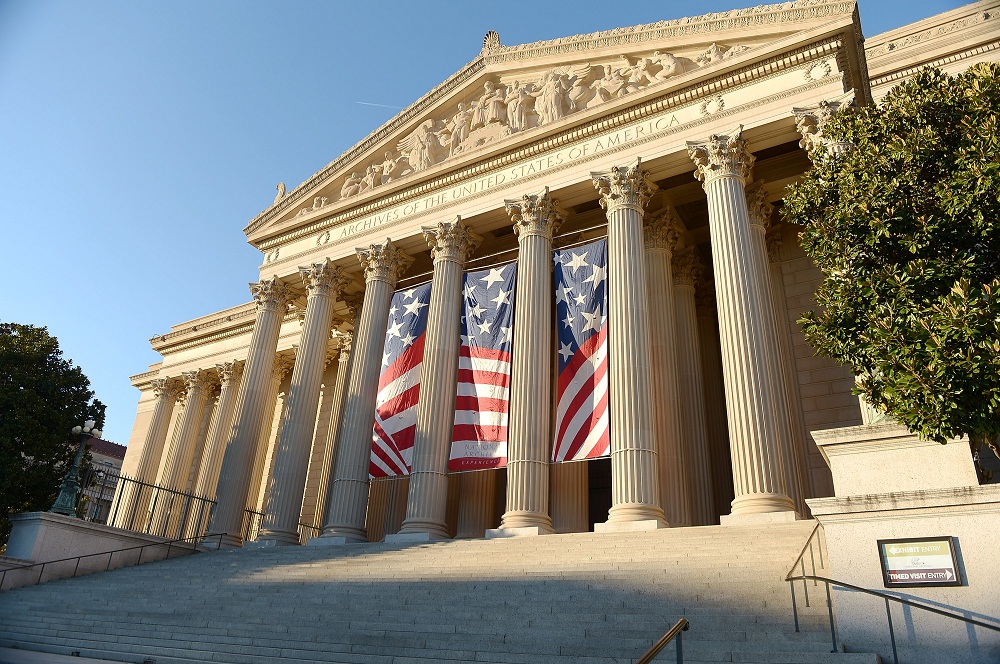On March 11, 2016, the National Archives will open a new exhibition, Amending America. Featuring more than 50 original documents from the National Archives, this exhibit highlights the remarkably American story of how we have amended, or attempted to amend, the Constitution in order to form “a more perfect union.” Next year, 2016, marks the 225th anniversary of the Bill of Rights, written in 1789 and ratified on December 15, 1791. The original Bill of Rights, on permanent display in the National Archives Rotunda for the Charters of Freedom, is still closely connected to the biggest issues of today–and to each of our citizens.
Amending America is free and open to the public, and will be on display in the Lawrence F. O’Brien Gallery of the National Archives Museum in Washington, DC, through September 4, 2017. Amending America is presented in part by the National Archives Foundation through the generous support of AT&T, HISTORY®, and the Lawrence F. O’Brien Family.
It is possible to amend the Constitution – but it’s not easy. Only 27 times—out of more than 11,000 tries—has Congress reached consensus to amend the Constitution. Amending America pulls back the curtain on this fascinating process and shares highlights from 225 years of renegotiating our fundamental governing contract. The 3,000 square foot exhibit includes petitions, interactives, landmark documents, and political cartoons addressing issues including child labor, prayer in schools, free speech, suffrage, civil rights, and more.
Learn about some of the 11,000 proposed (but not ratified) amendments including:
- H.R. 8 – to prohibit any person involved in a duel from holding federal office (1838).
- H.J. Res. 159 – to extend voting rights to widows and spinsters who are property holders (1888)
- H.J. Res. 661 to prohibit drunkenness (1938, five years after the repeal of Prohibition)
- Petition for a constitutional amendment to expel members of Congress who are absent for more than 40 percent of roll call votes (1971).
Additional exhibit highlights include:
- A list of more than 11,000 proposed amendments on a 225 foot banner stretching from the original Bill of Rights on display in the Rotunda to the O’Brien Gallery.
- An interactive which brings to life the 1846 introduced amendment to elect the President by lot. To see who might be Presidential candidates today if this amendment had been ratified, visitors can turn the crank to see the most popular people from each state (according to a Google search).
- A comic book, one of over 600 collected by the Senate Judiciary Subcommittee on Juvenile Delinquency during a 1954 investigation to determine if such comics contributed to youth crime.
- Visitors will be able to “vote” for the 28th Amendment by texting their response from their own cell phones.
Amending America is divided into 4 sections:
- Our Rights documents the expansion of rights to a wider range of people — a defining characteristic of America – and addresses questions including “Does flag burning equal free speech?” and “Should there be prayer in schools?”
- Refining Powers explores attempts to expand or contract the powers of government, such as regulation of child labor, alcohol sales, and English as the official language.
- The Shape of our Government explores how Americans have tried to find the formula for “a more perfect union” and explores proposed amendments to abolish the Electoral College and exclude bankers from serving in Congress, and hold public referendums to overturn Supreme Court decisions.
- How We Amend traces the trajectory from an idea to an amendment. Article V of the Constitution sets out the rules, but the process is often messy and lengthy. Learn what factors contribute to success or failure of proposed amendments.
Visitors to Amending America will discover answers to the following questions:
- What is the Archivist of the United States’ role in the amendment process?
- Does the First Amendment’s protection of the free press include crime and horror comic books aimed at children?
- Why did Connecticut, Georgia and Massachusetts symbolically ratify the Bill of Rights in 1939, not 1791?
The National Archives Museum is located on the National Mall on Constitution Ave. at 9th Street, NW. Hours are 10 a.m. to 5:30 p.m. daily, except Thanksgiving and December 25.
Related online resources from the National Archives Center for Legislative Archives
The Center for Legislative Archives is the unit within the National Archives that preserves the official records of the U.S. House of Representatives and the U.S. Senate. “Congress Creates the Bill of Rights: Completing the Constitution,” created by this office, outlines the relationship between the Constitution and the Bill of Rights. Available online.
# # #
For more information about Amending America or to obtain images of items included in the exhibition, call the National Archives Public Affairs staff at 202-357-5300.
